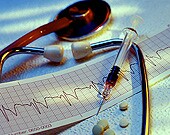
MONDAY, June 13 (HealthDay News) — Patient-focused outcomes are emphasized in 10 updated performance measures for people with coronary artery disease and hypertension that were released Monday by a trio of major U.S. medical groups.
“These measures are primarily intended for the use of individual practitioners and group practices in their efforts to improve the care of patients with hypertension and those with stable coronary disease,” Dr. Joseph Drozda Jr., director of outcomes research at Sisters of Mercy Health System in St. Louis, Mo., and co-chairman of the writing committee for the new measures, said in an American College of Cardiology news release.
“By adhering to the specifications called for in this measures set, entities operating such accountability programs can be assured of having high quality and clinically meaningful measures,” he added.
The measures were released by the American College of Cardiology Foundation, the American Heart Association and the American Medical Association-convened Physician Consortium for Performance Improvement.
The coronary artery disease measures include:
- Blood pressure control: Adults should obtain a blood pressure of less than 140/90 mm Hg. If that target cannot be reached, at least two antihypertensive medications should be prescribed.
- Lipid control: Patients should achieve an LDL (“bad”) cholesterol level of less than 100 mg/dL. If they can’t reach that target, their doctor should document a plan of care to lower their LDL level, which includes at minimum the prescription of a statin.
- Symptom and activity assessment: Doctors should evaluate patients’ activity levels and the corresponding presence or absence of angina symptoms. Angina is chest pain or discomfort that occurs when the heart does not get enough blood.
- Symptom management: For someone with angina, a doctor should document a plan of care to manage symptoms.
- Tobacco use: Patients should be screened for tobacco use and should receive tobacco-cessation counseling, if needed.
- Antiplatelet therapy: Physicians should prescribe aspirin or clopidogrel.
- Beta-blocker therapy: It should be prescribed for people with prior myocardial infarction or a left ventricular ejection fraction of less than 40 percent.
- ACE inhibitor/ARB therapy: This should be prescribed for people with diabetes or a left ventricular ejection fraction of less than 40 percent.
- Cardiac rehabilitation referral: Early referrals should be made for people who’ve had an acute heart attack, coronary artery bypass graft surgery, stenting, cardiac valve surgery or a heart transplant.
In the area of hypertension, the new measures include:
- Blood pressure control: Patients should have a blood pressure of less than 140/90 mm Hg. If their blood pressure is higher, at least two antihypertensive medications should be prescribed.
“This report represents an update and revision of guidelines last published in 2005” and “clearly outlines what is appropriate care for patients with coronary artery disease and/or hypertension,” said Dr. Louis Evan Teichholz, chief of cardiology and medical director of cardiac services at Hackensack University Medical Center in New Jersey. “A significant change is the addition of cardiac rehabilitation referral from an outpatient setting.”
Although the blood pressure and lipid guidelines have not changed much, he said, both are “in the midst of revision and new recommendations will be available late in 2011 or early 2012.”
More information
The U.S. National Heart, Lung, and Blood Institute has more about coronary heart disease.

